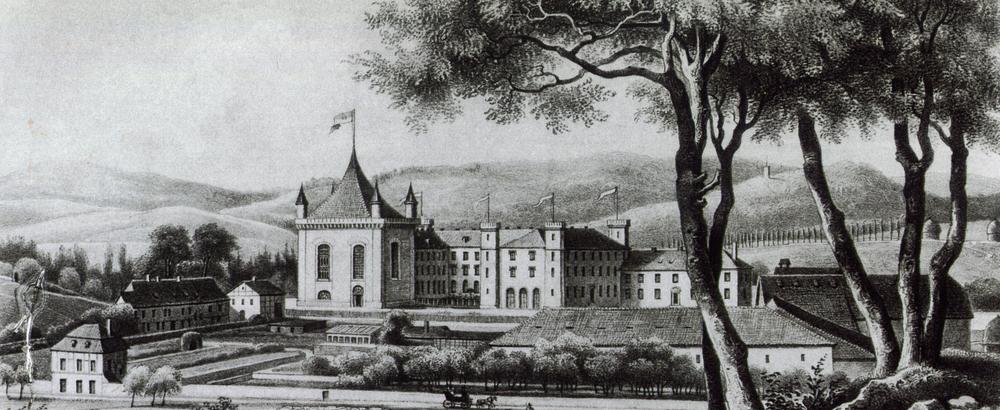
Schloss Derneburg's history dates back almost a thousand years.
Originally a fortified castle, by the twelfth century Schloss Derneburg had become the manor house of Margrave Herman I von Winzenburg and his brother Heinrich. Herman feuded with his vassall, Graf Burchard I von Loccum, and in 1130 arranged to have him murdered. Unfortunately for Herman, Burchard was a close friend of Kaiser Lothar III and the latter had the von Winzenburgs forfeit their properties as punishment. Derneburg was assumed by the Bishopric of Hildesheim with the stipulation that a religious sanctuary be founded there. Thus began Derneburg's new role as the home of various religious orders, a role it played for nearly seven hundred years.
The first religious group to settle at Derneburg were Canons Regular of St. Augustine, who established an abbey or canonry there in 1143. In 1213, it became an Augustine women's canonry when the Bishop of Hildesheim settled Canonesses Regular there from the nearby abbey in Holle. Derneburg began to flourish and its endowments and properties grew rapidly. The abbey took over the neighboring village of Astenbeck (whose own history dates to 826) and many other properties in its vicinity. In time however, the very success of the Derneburg abbey became its downfall. The Augustine sisters, perhaps enamored of their economic success, took an increasingly liberal interpretation of their religious obligations. By the beginning of the 14th century their reputation began to suffer -- endowments declined as did the fortunes of the abbey. By the beginning of the 15th century the sisters paid scant regard to their holy duties and the reformer, Provost Johannes Busch, became so scandalized by the situation at Derneburg that he tried to get the sisters evicted. This in turn led to an attempt on his life, suspicion for which fell on the sisters. In 1443, Busch's successor, Heinrich Barnten, Abbot of Marienrode had the Augustine sisters literally carted out of Derneburg. He replaced them with nuns of the more pious Cistercian order from the Abbey at Woeltingrode, which at that time was enjoying enormous success under Abbess Mechtild von Schwicheldt. Shortly thereafter, Derneburg's fortunes were restored but now as a Cistercian convent.
This new period of prosperity was short-lived however. The region was wracked by the secular and religious wars associated with the reformation. In 1523, Derneburg came under the control of Erich I, Prince of Calenberg-Goettingen and Duke of Braunschweig-Lueneburg. His wife, Elisabeth of Brandenburg, was known as “the reforming princess”, and Derneburg became a Lutheran convent and the property of the Dukes of Brunswick until the 17th century. When the Bishopric of Hildesheim was reunified in 1643, the Cistercians returned to Derneburg. In 1651 however, the convent was converted to a monastery. The Cistercian monks set to the task of repairing the extensive damage that had been sustained during the thirty year's war. Under Abbot Arnu they embarked on an ambitious building program that erected most of the buildings still visible today. In particular, between 1735 and 1749, they built a large baroque church - part of which remains today as the Knight's Hall (or Rittersaal) - on the southern end of the abbey, and the extensive domain buildings to the west of the abbey.
In 1803 the monastery at Derneburg was secularized by the Prussians and became a domain of the state. Four years later, Napoleon's troops seized and plundered it. Following Napoleon's defeat and the Congress of Vienna, in 1815 Derneburg reverted to the Bishopric of Hildesheim which had become part of the Hanoverian Kingdom under the rule of George III of England. The latter gave Derneburg to Graf Ernst zu Muenster in gratitude for the successful negotiations he had conducted at the Congress of Vienna on the king's behalf. Graf Ernst commissioned the renowned Hanoverian architect Georg Laves to reconfigure the monastery as a stately home. The monks' dormitories were converted to living and reception rooms and the baroque church of the Cistercians became a display space for the Muensters' extensive collection of paintings and antiquities. (Graf Ernst was a painter himself). Extensive landscaping was undertaken to create the effect of an English garden, with footpaths snaking down to the banks of the River Nette. These works were continued by Ernst's son Georg, again with Laves' help. In particular, Laves razed part of the Baroque church to create a “knights' hall” in an English gothic style. Georg also added to the lands of the estate. Like his father, he was an accomplished diplomat, serving as the Hanoverian ambassador at the court of the Czar and then under Bismarck in London, Paris and The Hague. In 1899 Kaiser Wilhelm II named him Prince Muenster of Derneburg.
Derneburg remained in the Muenster family for another 75 years. During the Second World War it became a military hospital, first for the Germans, then the English. After the war it served for a number of years as a home for elderly Silesian refugees until the Muensters returned. Most of the land of the estate was sold to the State of Lower Saxony in the early 1950s. The Schloss was acquired by Georg Baselitz in 1974 who made it his home and studio for the next 32 years until its sale in 2006. Since then, and in cooperation with the Schloss Derneburg Museum gGmbH, the adjacent buildings have been reunited with the property and have undergone extensive renovations in order to open as a public museum to present the exhibitions of the Hall Art Foundation.
